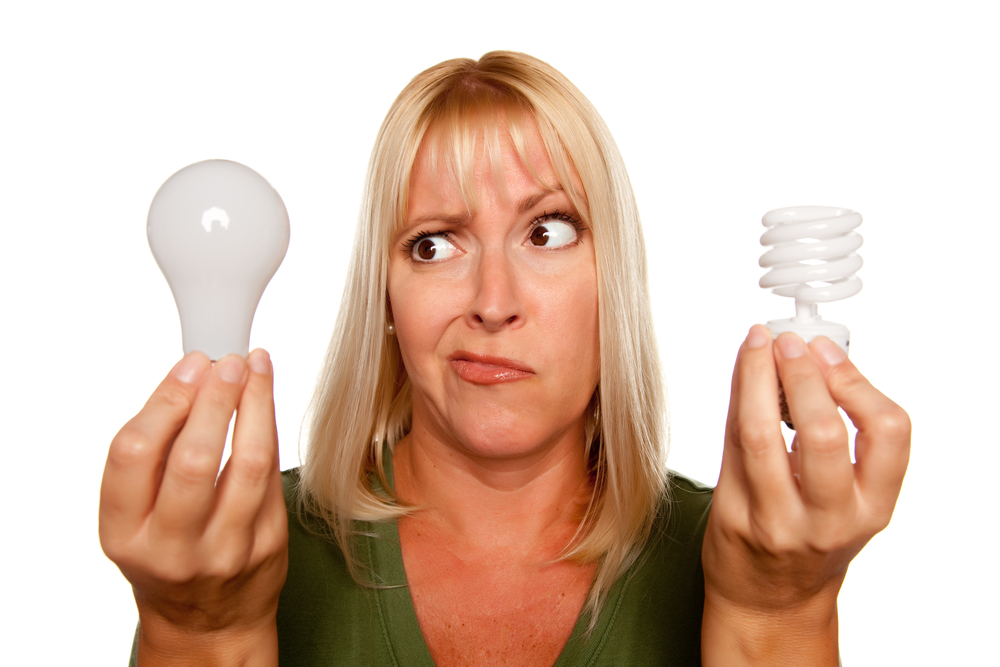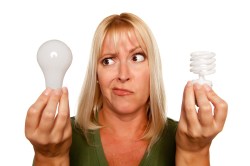Send your question to Umbra!
Q. Dearest Umbra,
I know you’ve written about lightbulbs before, but it seems like there are lots of new options on store shelves. Are incandescents even being sold anymore? And what about LED lights? I tried some a few years ago and, in addition to being hella expensive, the light they gave off was cold and blue and institutional — I couldn’t stand it. Are there other low-energy varieties? Which kinds of bulbs work with dimmers? Can you — ahem — shed some light on this confusing subject?
Liza E.
Battle Creek, Mich.
A. Dearest Liza,
Thanks for reminding me that it’s time for our semi-demi-hexi-annual revisitation of the lightbulb topic. And what better day than Earth Day to undertake this quest? For years, “change a lightbulb” has been cited as a simple step people can take to help the planet. Now even that command is starting to feel complicated, a state of affairs that does not help our cause.
But I promise it’s not really as complicated as all that. For those with short attention spans, the answer is: Go buy LEDs.
Here’s the rest of the story: Back in 2007, George W. Bush (you remember him) signed an Energy Bill that, among other things, intended to make America more energy efficient. It included regulations that would end the manufacture of wildly inefficient lightbulbs. Some political shenanigans ensued, but the short version is that in 2012, the phaseout of conventional incandescent bulbs began, starting with the 100-watt varieties. This year, 75-watt bulbs are to get the heave-ho, followed by 60-watt and 40-watt models. Should you wish to know more, the EPA has a handy explainer on the topic. This shift could save U.S. households $6 billion in 2015 alone, says the agency — check out this calculator to see figures specific to your house.
In general, new lightbulbs = good news. But new lightbulbs can also feel confusing and expensive when we’ve spent our lives grabbing a familiar 75-watt bulb and paying $1 for it. So here’s a little refresher on our options:
Halogen incandescents are as close as you can get to the familiar incandescent bulbs now being phased out. These high-tech versions of the old standby last two to three times longer and use about 25 percent less energy. They look the same as the old versions, so they may be comforting to people who think newfangled bulbs are weird. They can also be used in your dimmers! This is an area of product development that might be worth keeping an eye on: One consultant told The New York Times that the bulb regulations, when they were brand new, had spurred “more incandescent innovations in the last three years than in the last two decades.” But you’ll still save more money and energy with a CFL or LED.
Compact fluorescents (CFLs) last 10 times as long as traditional incandescents and use 75 percent less energy. They are a very good energy-saving option, and some can be used in dimmers (check individual packaging), but they have drawbacks. They contain a tiny amount of mercury, which means you can’t just toss them in the trash — though disposal has gotten easier thanks to recycling programs at major retailers including Home Depot and IKEA. CFLs also require some relearning: We should not turn them off as religiously as we’ve been trained to do with incandescents, because they actually have a finite number of on-off cycles. Frequent switching can be one reason they burn out early. Here are a few other things that can do in a CFL.
Light-emitting diodes (LEDs) last 25 times as long as the old incandescents and use 75 percent less energy as well. Honestly, Liza, they are the way of the future. Scratch that: They are the way of the now. Forget your cold blue experience of yesteryear and look into the array of options available today, many of which are covered in this helpful New York Times review. LEDs get bright immediately (as opposed to having an annoying “warm-up” period like CFLs), aren’t weakened by on-off cycling, and can be used in your dimmer. Yes, they are expensive up front, but their price has dropped dramatically in the last couple of years, and should continue to do so. If you can manage $5 to $10 for a bulb, I promise it will pay off handsomely over time in lower energy bills, less bulb-changing, less pollution from the power plants that electrify our homes, less shopping, and less angst.
By the way, if you really want to geek out on the topic of lighting, here’s a fun quiz from the folks at National Geographic. You might even learn enough to concoct a strange new sign-off.
Ediswanly,
Umbra




